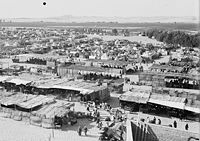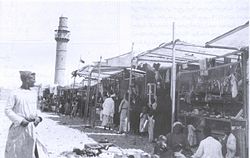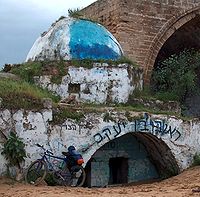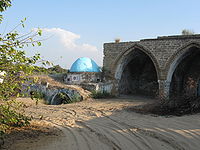- Nabi Rubin
-
al-Nabi Rubin 
Pilgrim encampments in Nabi Rubin between 1920-1933Arabic النبي روبين Name Meaning "The Prophet Reuben" Also Spelled al-Nebi Rubin District Ramla Coordinates 31°55′45.59″N 34°44′01.37″E / 31.9293306°N 34.7337139°ECoordinates: 31°55′45.59″N 34°44′01.37″E / 31.9293306°N 34.7337139°E Population 1,420 (1945) Area 31,002 dunums 31.0 km²
Date of depopulation June 1, 1948[1] Cause(s) of depopulation Expulsion by Yishuv forces Current localities Palmachim, Gan Sorek Al-Nabi Rubin (Arabic: النبي روبين, transliteation: an-Nabî Rûbîn) was a Palestinian village in central Palestine, located 14.5 kilometers (9.0 mi) west of Ramla,[2] just northeast of Yibna and 18 kilometers (11 mi) south of Jaffa.[3] The village was situated on the southern banks of Wadi al-Sarar, also known as Sorek Stream, at an elevation of 25 meters (82 ft) below sea level. Nabi Rubin is named after a shrine in the village, believed by Muslims to be the tomb of Reuben.[2] In Sami Hadawi's 1945 land and population survey, Nabi Rubin had a population of 1,420 inhabitants and a total land area of 31,002 dunams, of which 683 were planted with citrus trees with no built-up area.[4] It was captured by the Israel Defence Force during the 1948 Arab-Israeli War, and the inhabitants were expelled.
Contents
History
Nabi Rubin was a place of trade between Crusaders and Muslims prior to it being inhabited. In 1184, it held a fair where Arab merchants from Damascus traded slaves, Persian and Kurdish-bred horses, weapons, and blades from Yemen and India, with Christians from Acre. This trade continued until wars between the Mamluks and Crusaders commenced in the 13th century.[5]
The Mamluk governor of Jerusalem built a mosque and shrine there in the early 15th century. Islamic judge Mujir ad-Din wrote in 1495 it "is a tomb of our Reuben," thereon crystallizing in local Muslim tradition that the site is the burial place of Reuben, son of Jacob and Leah. Despite popular belief, the tomb may possibly be that of an Arab sheikh.[3] Walid Khalidi writes that it is believed that the shrine for al-Nabi Rubin was built in the same place where a Canaanite temple had once stood, and that the mawsim ("religious festival") itself was pagan in origin.[6] The Nabi Rubin mawsim was one of two prominent mawsims for Old Testament prophets in Palestine—the other being dedicated to Nabi Musa ("the prophet Moses") near Jericho.[7]
The site comprised a mosque, a minaret, (now demolished), and a maqam, as well as at least nine wells dispersed in the sand dunes nearby.[8] The oldest part of the present structure is the maqam, which, according to an inscription, was built under the orders of the governor Timraz al-Mu'ayyadi between 1436 and 1437 C.E. A cross-vaulted room to the east was built slightly later, possibly in the 16th century. The rest of the complex was built in the later Ottoman period, probably in the 19th century.[9]
Since at least the 17th century, Muslims from Jaffa, Ramla, Lydda, and the towns and villages surrounding these cities, flocked to Nabi Rubin to celebrate the mawsim.[10] In 1816, an English traveler, Irby, visited the "Sheik Rubin´s tomb, surrounded by a square wall, inclosing some trees". He also describes that [local] people paid vows at the shrine and celebrated festivals there.[11] Up to 30,000 people made the pilgrimage annually throughout the month of August.[10] Temporary coffeehouses, restaurants, and stalls selling food and other merchandise were set up, and people sang popular songs, — both religious and nationalist — and danced the traditional dabka. Sufi dervishes held dhikr sessions, and pilgrims also watched horse races, magic shows and listened to sermons from imams and poets. City wives, who virtually never socialized outside households, in particular "craved participation in the festival," and Tawfiq Canaan writes that they would announce to their husbands "Either you take me to Nabi Rubin, or you divorce me."[12] In 1933, during the Nabi Rubin celebrations, Arabs went on strike and rioted against British Mandatory rule.[13] The first Palestinian film, a 1935 documentary, was also presented at the Nabi Rubin festivals.[14] The writer S. Yizhar, who as a child sneaked over the sands from his home in Rehovot, later described:
"One finally arrives at Nabi Rubin and its mosque in the center, to watch by the light of bonfires...or even electricity from portable generators, the performance of the dances, the whirling of the dervishes, the colorful candy wrappers,...the pot-bellied swaying Gypsy woman ....while on the side, the singing keeps sawing away all time, not ceasing until the depths of night..." [15]
The village
The village of Nabi Rubin was first settled by members of the Abu Sawayrih tribe in the 1930s and '40s who are descendants of the al-Maliha Bedouin tribe who used dwell in the Sinai Peninsula. In 1944, a boy's school was built, and by 1946 it had an enrollment of 55 pupils.[2] The village's land area, most of which was covered by sand dunes, was the second largest in the district after that of Yibna, and was designated as an Islamic waqf ("pious endowment"). Some of the houses, which were scattered across the site without any discernible nucleus, were also built inside the fruit orchards. Shops, as well as a movie theater, were built in the neighborhood of the shrine. The villagers worked in agriculture and animal husbandry; they also catered to the visitors during the mawsim. They cultivated mainly grain, followed by citrus and other fruits, such as figs and grapes. In 1944-45 a total of 683 dunums was devoted to citrus and banana cultivation, and 4357 dunums were allocated to cereals. Another 184 dunums were irrigated or used for orchards.[16]
Capture by Israel
Nabi Rubin was located in a region which was targeted by Haganah´s "Operation Lightning" (Mivtza Barak) during the 1948 Arab-Israeli War, which aimed to force the Arab inhabitants to move. During the 10–12 May 1948, units of the Ephraim sub-district, apparently without success, repeatedly mortared and raided Nabi Rubin, with the aim of forcing evacuation.[17]
On June 1, 1948, Israel's Giv'ati Brigade captured the village in the second stage of Operation Barak. Upon its capture, most of its inhabitants were expelled, except for a few who stayed until the harvest season to collect oranges, but they too were later expelled. On the 24 August, the Giv'ati Brigade HQ issued the order for Mivtza Nikayon (Operation Cleaning), aiming at ´cleansing [letaher]´the newly conquered area which included Nabi Rubin. Any armed units were to be destroyed, and any Arab civilians expelled. The operation took place on 28 August, and they "killed 10 Arabs, wounded three and captured 3". There were no IDF casualties.[18]
According to Salman Abu-Sitta, in 1998, there were 10,116 Palestinian refugees from Nabi Rubin or their descendants.[2]
Walid Khalidi describes Nabi Rubin after its capture:
The shrine of al-Nabi Rubin stands amid shrubs and other wild vegetation. A minaret that has three lancet-arched entrances stands at one end of it. A number of minor shrines built of large stones also remain. Near the shrine is a deserted, free-standing cement structure that consists of a single, box-shaped room.[2]
The shrine of Reuben remained abandoned and deteriorated gradually; by 1991, the minaret of the mosque was torn down, as were centuries-old mulberry trees that had been located in the courtyard. Eventually, the shrine was reconsecrated as a Jewish holy site (although Jews have traditionally placed Reuben's tomb in the Lower Galilee). The green curtain with the script "There is no god, but God, and Rubin is his prophet" which had been laid on the tomb was replaced by a red one with "Reuben, thou art my firstborn, my might, and the beginning of my strength."[12]
See also
- List of Arab towns and villages depopulated during the 1948 Arab-Israeli War
- List of villages depopulated during the Arab-Israeli conflict
- Nabi Musa
- Nabi Salih
References
- ^ Morris, 2004, p. XIX, village #253. Also gives cause of depopulation.
- ^ a b c d e Welcome to al-Nabi Rubin Palestine Remembered.
- ^ a b Gonen, 2000, p.209.
- ^ Hadawi, Sami. (1970). 1945 District of al-Ramla Statistics Palestine Liberation Organization Research Center, p.67.
- ^ Conder, 1886, pp.447-448.
- ^ Khalidi, 1992, p.401.
- ^ Khalidi, 1992, p.403
- ^ Petersen (2002), p.229.
- ^ Petersen, 2002, p.232.
- ^ a b Benvenisti, 2002, p . 274
- ^ Irby, 1852, p.57
- ^ a b Benvenisti, 2002, pp.274-276.
- ^ Liebreich, 2005, p.35.
- ^ Gertz and Khleifi, p. 13
- ^ Yizhar: "Silence of the Villages" (in Hebrew), in Stories of the Plain, (Tel Aviv: Zmora Bitan, 1990), 116-17. Cited in Benvenisti, 2000, p. 275
- ^ Khalidi, 1992, p.403
- ^ Morris (2004), p. 256, citing: "´Ephraim´Sub-district to ´Ya´akov´, ´Report on Harassment Operation in "Rubin"´, 13 May 1948, Israeli Defence Forces and Defence Ministry Archive 1041\49\\7." (Note 757, p. 305)
- ^ Morris, 2004, p.444,
Bibliography
- Benvenisti, Meron (2002), Sacred Landscape: The Buried History of the Holy Land Since 1948, University of California Press, ISBN 9780520234222, http://books.google.com/?id=7itq6zYtSJwC&pg=PA274&dq=Nabi+Rubin+Ramla
- Clermont-Ganneau, Charles Simon (1896): Archaeological Researches in Palestine 1873-1874, [ARP], translated from the French by J. McFarlane, Palestine Exploration Fund, London. Volume 2. p.163- 164.
- Conder, Claude Reigner (1886), Syrian Stone-lore, R. Bentley and Son, http://books.google.com/?id=Cx4cAAAAMAAJ&pg=RA1-PA448&dq=Neby+Rubin
- Conder, Claude Reignier and H.H. Kitchener (1881): The Survey of Western Palestine: memoirs of the topography, orography, hydrography, and archaeology. London:Committee of the Palestine Exploration Fund. vol 2, p.269.
- Gertz, Nurith; Khleifi, George (2008): Palestinian Cinema: Landscape, Trauma, and Memory, Indiana University Press. ISBN 0253220076
- Guérin, M. V. (1869): Description géographique, historique et archéologique de la Palestine. Judee (p.52 )
- Hadawi, Sami (1970), Village Statistics of 1945: A Classification of Land and Area ownership in Palestine, Palestine Liberation Organization Research Center, http://www.palestineremembered.com/Articles/General-2/Story3150.html
- Irby, Charles Leonard, James Mangles, Henrich Steffens (1852):Travels in Egypt and Nubia, Syria, and the Holy Land: including a journey round the Dead Sea, and through the country east of the Jordan Published by J. Murray, 150 pages
- Khalidi, Walid (1992), All That Remains: The Palestinian Villages Occupied and Depopulated by Israel in 1948, Washington D.C.: Institute for Palestine Studies, ISBN 0887282245
- Liebreich, Fritz (2005), Britain's Naval and Political Reaction to the Illegal Immigration of Jews to Palestine, 1945-1948 1948, Routeledge, ISBN 9780714656373, http://books.google.com/?id=LsgnW34jp90C&pg=PA35&dq=Nebi+Rubin
- Mayer, L. A. (1933), Saracenic Heraldry: A Survey, Oxford University Press, Oxford. (P. 230-231, pl. LIX.1. Cited in Petersen, 2002)
- Morris, Benny (2004), The Birth of the Palestinian Refugee Problem Revisited, Cambridge University Press, ISBN 0521009677
- Palmer, E. H. (1881): The survey of Western Palestine: Arabic and English name lists collected during the survey by Lieutenants Conder and Kitchener, R. E. Transliterated and explained by E.H. Palmer. p.217
- Petersen, Andrew (2002): A Gazetteer of Buildings in Muslim Palestine: Volume I (British Academy Monographs in Archaeology) P. 229-232.
- Rivka, Gonen (2000), Biblical Holy Places: An Illustrated Guide, Paulist Press, ISBN 9780809139743, http://books.google.com/?id=69u5nFnfkVYC&pg=PA209&dq=Nebi+Rubin
External links
 Arab towns and villages depopulated during the 1948 Palestine War
Arab towns and villages depopulated during the 1948 Palestine WarAcre al-Amqa · Arab al-Samniyya · al-Bassa · al-Birwa · al-Damun · Dayr al-Qassi · al-Ghabisiyya · Iqrit · Iribbin · Jiddin · al-Kabri · Kafr 'Inan · Kuwaykat · al-Manshiyya · al-Mansura · Mi'ar · al-Nabi Rubin · al-Nahr · al-Ruways · Suhmata · al-Sumayriyya · Suruh · al-Tall · Tarbikha · Umm al-Faraj · al-Zeeb
Baysan Arab al-'Arida · Arab al-Bawati · Arab al-Safa · al-Ashrafiyya · al-Bira · Beisan · Danna · Farwana · al-Fatur · al-Ghazzawiyya · al-Hamidiyya · al-Hamra · Jabbul · Kafra · Kawkab al-Hawa · al-Khunayzir · Masil al-Jizl · al-Murassas · Qumya · al-Sakhina · al-Samiriyya · Sirin · Tall al-Shawk · al-Taqa · al-Tira · Umm 'Ajra · Umm Sabuna, Khirbat · Yubla · Zab'a · al-Zawiya
Beersheba Gaza Arab Suqrir · Barbara · Barqa · al-Batani al-Gharbi · al-Batani al-Sharqi · Bayt 'Affa · Bayt Daras · Bayt Jirja · Bayt Tima · Bil'in · Burayr · Dayr Sunayd · Dimra · al-Faluja · Hamama · Hatta · Hiribya · Huj · Hulayqat · Ibdis · Iraq al-Manshiyya · Iraq Suwaydan · Isdud · al-Jaladiyya · al-Jiyya · Julis · al-Jura · Jusayr · Karatiyya · Kawfakha · Kawkaba · al-Khisas · al-Masmiyya al-Kabira · al-Masmiyya al-Saghira · al-Muharraqa · Najd · Ni'ilya · Qastina · al-Sawafir al-Gharbiyya · al-Sawafir al-Shamaliyya · al-Sawafir al-Sharqiyya · Simsim · Summil · Tall al-Turmus · Yasur
Haifa Abu Shusha · Abu Zurayq · Arab al-Fuqara · Arab al-Nufay'at · Arab Zahrat al-Dumayri · 'Atlit · Ayn Ghazal · Ayn Hawd · Balad ash-Sheikh · Barrat Qisarya · Burayka · al-Burj · al-Butaymat · Daliyat al-Rawha' · al-Dumun · al-Ghubayya al-Fawqa · al-Ghubayya al-Tahta · Hawsha · Ijzim · Jaba' · al Jalama · Kabara · al-Kafrayn · Kafr Lam · al-Kasayir · Khubbayza · Lid · al-Manara · al-Mansi · al-Mansura · al-Mazar · Naghnaghiya · Qamun · Qannir · Qira · Qisarya · Qumbaza · al-Rihaniyya · Sabbarin · al-Sarafand · Khirbat al-Sarkas · Khirbat Sa'sa' · al-Sawamir · Khirbat al-Shuna · al-Sindiyana · al-Tantura · al-Tira · Umm al-Shawf · Umm al-Zinat · Wa'arat al-Sarris · Wadi Ara · Yajur
Hebron 'Ajjur · Barqusya · Bayt Jibrin · Bayt Nattif · al-Dawayima · Deir al-Dubban · Dayr Nakhkhas · Kudna · Mughallis · al-Qubayba · Ra'na · Tell es-Safi · Umm Burj · az-Zakariyya · Zayta · Zikrin
Jaffa al-'Abbasiyya · Abu Kabir · Abu Kishk · Bayt Dajan · Biyar 'Adas · Fajja · al-Haram · Ijlil al-Qibliyya · Ijlil al-Shamaliyya · al-Jammasin al-Gharbi · al-Jammasin al-Sharqi · Jarisha · Kafr 'Ana · al-Khayriyya · al-Mas'udiyya · al-Mirr · al-Muwaylih · Rantiya · al-Safiriyya · Salama · Saqiya · al-Sawalima · al-Shaykh Muwannis · Yazur
Jerusalem Allar · Aqqur · Artuf · Bayt 'Itab · Bayt Mahsir · Bayt Naqquba · Bayt Thul · Bayt Umm al-Mays · al-Burayj · Dayr Aban · Dayr 'Amr · Dayr al-Hawa · Dayr Rafat · Dayr al-Shaykh · Deir Yassin · Ayn Karim · Ishwa · Islin · Ism Allah · Jarash · al-Jura · Kasla · al-Lawz · Lifta · al-Maliha · Nitaf · al-Qabu · Qalunya · al-Qastal · Ras Abu 'Ammar · Sar'a · Saris · Sataf · Sheikh Badr · Suba · Sufla · al-Tannur · al-'Umur · al-Walaja
Jenin Nazareth Indur · Ma'alul · al-Mujaydil · Saffuriyya
Ramla Abu al-Fadl · Abu Shusha · Ajanjul · Aqir · Barfiliya · al-Barriyya · Bashshit · Bayt Far · Bayt Jiz · Bayt Nabala · Bayt Shanna · Bayt Susin · Bir Ma'in · Bir Salim · al-Burj · al-Buwayra · Daniyal · Dayr Abu Salama · Dayr Ayyub · Dayr Muhaysin · Dayr Tarif · al-Duhayriyya · al-Haditha · Idnibba · Innaba · Jilya · Jimzu · Kharruba · al-Khayma · Khulda · al-Kunayyisa · al-Latrun · Lydda · al-Maghar · Majdal Yaba · al-Mansura · al-Mukhayzin · al-Muzayri'a · al-Na'ani · an-Nabi Rubin · Qatra · Qazaza · al-Qubab · al-Qubayba · Qula · Ramla · Sajad · Salbit · Sarafand al-Amar · Sarafand al-Kharab · Saydun · Shahma · Shilta · al-Tina · al-Tira · Umm Kalkha · Wadi Hunayn · Yibna · Zakariyya · Zarnuqa
Safad Abil al-Qamh · al-'Abisiyya · 'Akbara · Alma · Ammuqa · Arab al-Shamalina · Arab al-Zubayd · Ayn al-Zaytun · Baysamun · Biriyya · al-Butayha · al-Buwayziyya · Dallata · al-Dawwara · Dayshum · al-Dirbashiyya · al-Dirdara · Fara · al-Farradiyya · Fir'im · Ghabbatiyya · Ghuraba · al-Hamra' · Harrawi · Hunin · al-Husayniyya · Jahula · al-Ja'una · Jubb Yusuf · Kafr Bir'im · al-Khalisa · Khan al-Duwayr · Karraza, Khirbat · al-Khisas · Khiyam al-Walid · Kirad al-Baqqara · Kirad al-Ghannama · Lazzaza · Madahil · Al-Malkiyya · Mallaha · al-Manshiyya · al-Mansura · Mansurat al-Khayt · Marus · Meiron · al-Muftakhira · Mughr al-Khayt · al-Muntar · al-Nabi Yusha' · al-Na'ima · Qabba'a · Qadas · Qaddita · Qaytiyya · al-Qudayriyya · al-Ras al-Ahmar · Sabalan · Safsaf · Saliha · al-Salihiyya · al-Sammu'i · al-Sanbariyya · Sa'sa' · al-Shawka al-Tahta · al-Shuna · Taytaba · Tulayl · al-'Ulmaniyya · al-'Urayfiyya · al-Wayziyya · Yarda, Safad · al-Zahiriyya al-Tahta · al-Zanghariyya · al-Zawiya · al-Zuq al-Fawqani · al-Zuq al-Tahtani
Tiberias Awlam · al-Dalhamiyya · Ghuwayr Abu Shusha · Hadatha · al-Hamma · Hittin · Kafr Sabt · Lubya · Ma'dhar · al-Majdal · al-Manara · al-Manshiyya · al-Mansura · Nasir al-Din · Nimrin · al-Nuqayb · Samakh · al-Samakiyya · al-Samra · al-Shajara · al-Tabigha · al-'Ubaydiyya · al-Wa'ra al-Sawda', Khirbat · Yaquq
Tulkarm Khirbat Bayt Lid · Bayyarat Hannun · Fardisya · Ghabat Kafr Sur · al Jalama · Kafr Saba · al-Majdal · al-Manshiyya · Miska · Qaqun · Raml Zayta · Tabsur · Umm Khalid · Wadi al-Hawarith · Wadi Qabbani · al-Zabadida · Khirbat Zalafa
Categories:- Arab villages depopulated during the 1948 Arab–Israeli War
- District of Ramla
- Palestinian shrines
- Tombs of biblical people
Wikimedia Foundation. 2010.





